| Back to Back Issues Page |
 |
|
Bangkok Travelbug February 14 Ancient kilns in Ban Ko Noi Si Satchanala January 29, 2014 |
| Hello
Beyond the old city walls Si Satchanalai is a very old city almost 1,000 years old and even older according to some sources. There is sufficient archaeological evidence in the area to establish the age of this city at around 1,000 years. The city used to be called Chalieng and the name was later changed to Si Satchanalai. With the emergence of Sukhothai, Si Satchanalai was slowly relegated to a minor city. The remains of this former civilization occupy what is today called the Si Satchanalai Historical Park. The park covers 45.14 sq km and has about 287 old ruins. The ruins within the old city walls were covered in the last issue, please see Si Satchanalai Historical Park, Sukhothai This month we visit the ruins outside the city walls. These include some old temples and more importantly several ancient kilns used to produce the famous Sangkhalok ceramics. Not only were these old kilns discovered, several pieces of the old Sangkhalok ceramics were also found. 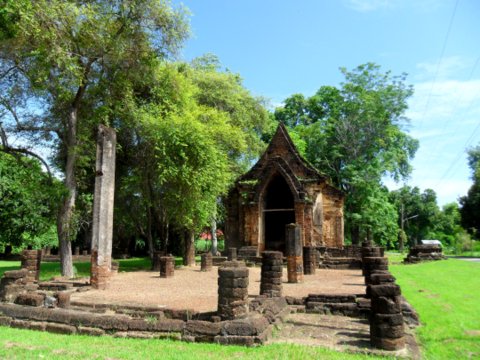
Wat Kudi Rai – ruins outside the old city walls These old kilns will be our next stop in our tour of Si Satchanalai. Table of contents Ban Ko Noi Ban Ko Noi is a little village about five km north of the old city of Si Satchanalai. This 1.5 km stretch of country road on the west bank of the Yom River and parallel to Highway 1201 is considered part of the historical park as it is home to about 200 old kilns dating back to the 13th C. Research and excavation of these kilns started as far back as the 1960s all the way to the 1980s.These efforts combine research, excavation and conservation. Archaeologists working with the Fine Arts Department have excavated several of these kilns which were of different shapes and designs and numbered them. Some of these kilns were underground, so were several large urns probably used for storing water or dry food. Most of the old kilns were grouped in two areas; Ban Ko Noi, five km north of the old city and Ban Pa Yang, a km to the south of Ban Ko Noi. In one of these groups of kilns that was discovered the scientists also found to their surprise 19 pieces of the famous Sangkhalok pottery which was very popular in S E Asia in the 13th – 16th C. 
Ban Pa Yang The results of these discoveries are now preserved in the Centre for Study & Preservation of Sangkhalok Kilns. Table of contents Centre for Study & Preservation of Sangkhalok Kilns The Centre for Study and Preservation of Sangkhalok Kilns was officially opened on 5 November 1987 by HRH the Crown Princess Sirindhorn. 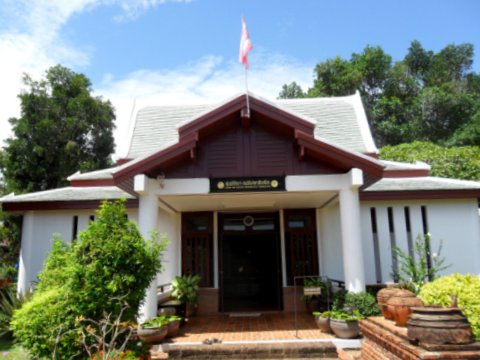
Centre for Study & Preservation of Sangkhalok Kilns The centre is divided into two sections.
Here are samples of some of the ceramics recovered; some of these are incomplete pieces. 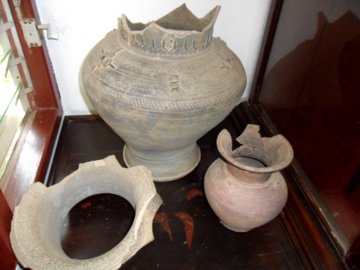


There are also plans showing cross-sections of the various types of kilns. Here’s a sample of the cross-section of a typical kiln. 
Views of a kiln The ceramics are placed in the centre section, the fire is at the bottom right corner and the chimney to release smoke is at the top left corner. 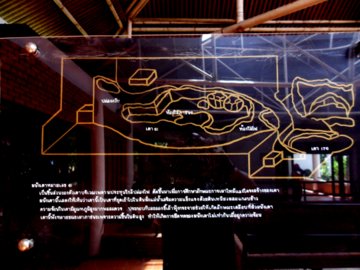
Cross-section of a kiln The second section of this museum is even more interesting. This is where the preserved excavation pits are located. The museum was probably built around these pits with their side walls reinforced and safety railing around the edges. Down in the pits visitors will be able to see the remains of the old underground kilns. 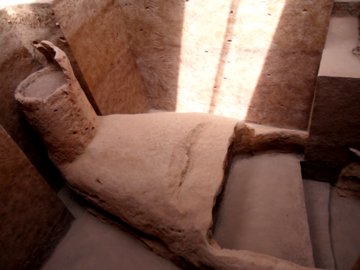
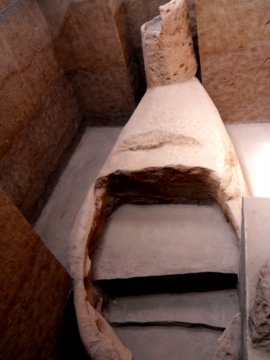
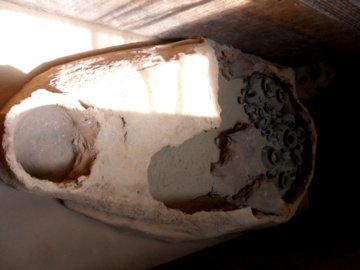

Some of these pits still have remnants of the old ceramics. Here are some of the shattered pieces that were recovered and painstakingly glued together. 
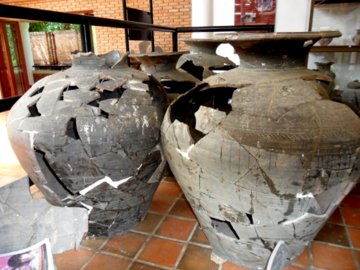
It’s hard to imagine that these relics are more than 800 years old! Table of contents Prasert Antiques Across the road from the centre, there’s an interesting souvenir shop, Prasert Antiques. They are not really antiques though but some of them have been made to look old. There’s a wide range of pots, vases and statues that look quite attractive as ornamental pieces and some do have a practical purpose. 
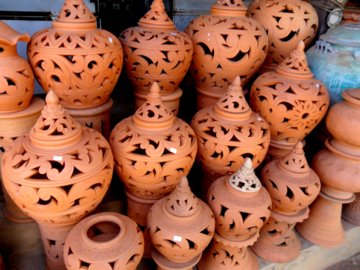
I bought this little pot which is useful for keeping loose coins and other small items like keys. This is the other purchase I made, one of those vases made to look old. 
The souvenirs I bought The owners of the place kindly invited me over to tour their workshop where there is a gas kiln to heat up the ceramics. 
Gas kiln – temperatures in excess of 1,000° C I also had a chance to see their craftsmen and women painting designs on some of the completed ceramics. 

Prasert Antiques is indeed a fitting complement to the Centre for Study and Preservation of Sangkhalok Kilns. 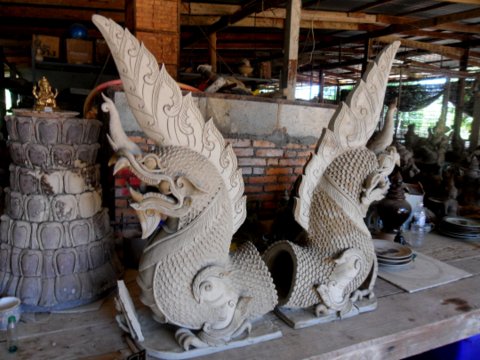
Some of the completed work in the workshop Table of contents Map to Ban Ko Noi View Ban Ko Noi - Si Satchanalai in a larger map How to get to there By tour bus Take a tour bus from Mor Chit the northern bus station in Bangkok to Si Satchanalai. Do not take the bus to Sukhothai city as it terminates at the city bus terminal. The bus to Si Satchanalai bypasses Sukhothai city, passes Sawan Khalok, Si Satchanalai and ends at Phitsanulok. Fare is 409 baht to Si Satchanalai. I chose to stay in Sawan Khalok because of this beautiful hotel that came highly recommended. The fare for the return trip from Sawan Khalok to Bangkok is 387 baht. Where to stay I stayed at this beautiful hotel called Sawankaburi Boutique Hotel for 800 baht per night. The rooms are comfortably furnished with traditional Thai décor of wood paintings and ceramics. 
Sawankaburi Boutique Hotel Getting around Si Satchanalai Public transport in Si Satchanalai consists of motor cycles and public buses running on regular routes. It would be difficult for someone from out of town to be familiar with these in a short period. The best alternative is to enquire with the hotel where you are staying to rent a car. Ban Ko Noi is about 5 km north of the old city on the road that along the west bank of the Yom River. Table of contents Other attractions in and near Si Satchanalai
Table of contents My thanks I am grateful to Lumpoo Pramchit for showing me the historical and cultural sites in her home province of Sukhothai. Table of contents Next month We visit the Sawankhavoraknayok National Museum, Sawan Khalok, Sukhothai. 

If you enjoyed reading this e-zine, please forward it to a friend. If you received this from a friend and found it interesting, please subscribe at Bangkok Travelbug. What you think of the Bangkok Travelbug? We love to hear from you What other subscribers have said Till next month then. Eric Lim Find us on Facebook Stay updated with what’s new at Tour Bangkok Legacies. Copy the link below and paste it into your Google Reader, NetNewsWire or your favourite feed reader. https://www.tour-bangkok-legacies.com/tour-Bangkok-legacies.xml If you use My Yahoo! or My MSN, head over to my home page and click on the button for your favourite Web-based feed reader. Visit our home page at Tour Bangkok Legacies. Copyright@2008-2013 Tour Bangkok Legacies All rights reserved |
| Back to Back Issues Page |